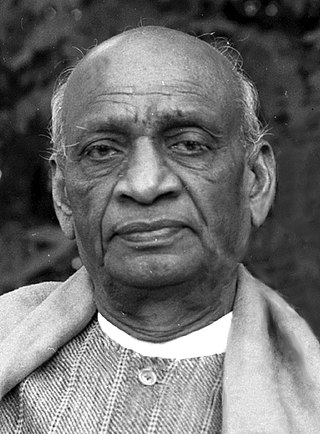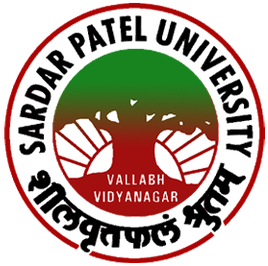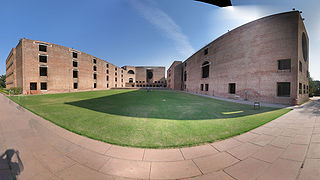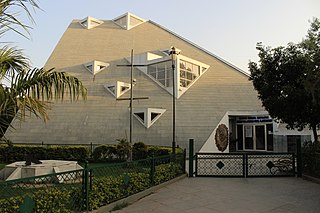
Vallabhbhai Jhaverbhai Patel, commonly known as Sardar Vallabhbhai Patel, was an Indian independence activist and barrister who served as the first Deputy Prime Minister and Home Minister of India from 1947 to 1950. He was a senior leader of the Indian National Congress, who played a significant role in the Indian independence movement and India's political integration. In India and elsewhere, he was often called Sardar, meaning "Chief" in Hindi, Urdu, Bengali and Persian. He acted as the Home Minister during the political integration of India and the Indo-Pakistani War of 1947.

Ahmedabad ( AH-mə-də-ba d; is the most populous city in the Indian state of Gujarat. It is the administrative headquarters of the Ahmedabad district and the seat of the Gujarat High Court. Ahmedabad's population of 5,570,585 makes it the fifth-most populous city in India, and the encompassing urban agglomeration population estimated at 6,357,693 is the seventh-most populous in India. Ahmedabad's 2024 population is now estimated at 8,854,444. Ahmedabad is located near the banks of the Sabarmati River, 25 km from the capital of Gujarat, Gandhinagar, also known as its twin city.

Sardar Vallabhbhai Patel International Airport is an international airport serving the twin cities of Ahmedabad and Gandhinagar in Gujarat, India. It is named after Sardar Vallabhbhai Patel, the first Deputy Prime Minister of India. The airport is the busiest and largest airport in the state of Gujarat, and is the seventh busiest airport in India.

Sardar Patel University (SPU) is a public state university in Vallabh Vidyanagar, a Anand City Gujarat, India. It is named after the iron man of India Vallabhbhai Patel, and was founded in October 1955 by an Act of the Legislative Assembly of the then-Bombay Province and was UGC recognized under 2(f) of the UGC Act in October 1968. Originally, it had the status of a rural university but now it has diversified with the motto of "Excellence Matters".

The Narendra Modi Stadium (NMS), formerly known as Motera Stadium, is an international cricket stadium in Ahmedabad, Gujarat, India. It is the largest stadium in the world, with a seating capacity of 132,000 spectators. The stadium is owned by the Gujarat Cricket Association and serves as the venue for domestic and international cricket matches. It is one of the world's premier cricket stadiums.
Karamsad is a City and Karamsad is a municipality under the Anand Municipal Corporation. Anand Municipal Corporation limits are visible all around.. in Anand district in the Indian state of Gujarat. It is part of the Chhagaam Gol.

According to the 2011 national census, the population of Ahmedabad was declared to be 7,214,225. This figure was only limited to the municipality region. The total population of the Ahmedabad Urban Agglomeration came to 7.2 million people. There were 886 females to every 1000 males in 2001. Now there are 904 women to 1000 men in 2011. Ahmedabad had a literacy rate of 79.89% in 2001 which rose to 89.62 percent in 2011. Out of this, male and female literacy are 93.96 and 84.81 percent as of 2011 census. According to the census for the ninth plan, there are 30737 rural families living in Ahmedabad. Out of those, 5.41% live below the poverty line. There are 439,843 people who live in slums in the city. The majority of residents of Ahmedabad are native Gujaratis and speak Gujarati. There is also a sizable population of Punjabis, Marathis, Tamils, Sindhis, Malayalis and Marwaris who bring in their native language and culture to the city. The government institutions and military base near the city also bring peoples from across India. The city's population has increased in a major way following increasing economic expansion and modernization.

Adalaj is a census town in Gandhinagar district located in the western Indian state of Gujarat. With a population of roughly 12,000 residents within the town limits as of 2011, Adalaj is known for its semi-arid climate and its historic and religious establishments. The town sits in a generally flat area covering about 18 sq. km.
Mahemdavad is a town with municipality in the Kheda district in the Indian state of Gujarat. Mahemdavad is situated on the Vatrak River bank. The nearest city is Kheda. It is 30 km from largest city of Gujarat, Ahmedabad.
Healthcare in Ahmedabad is provided through several hospitals and medical colleges – both government and private. In addition to providing healthcare to the Gujarat population, Ahmedabad also focuses on medical tourism and in 2009 received about 1,500 visitors from outside the state, including some from abroad.

Gujarat is a state situated in the western part of India and shares its northwestern boundary with Pakistan. Rajasthan, Madhya Pradesh and Maharashtra are the neighboring states of Gujarat. Gandhinagar is the capital city of the state and Ahmedabad is its largest city and the main commercial hub of the region. Gujarat houses a wide variety of industries and is considered one among the best industrialized states of the nation. Gujarat is also home to some of the prestigious educational institutes of the nation.

Sardar Vallabhbhai Patel Stadium is an Indian sports stadium located in the Navrangpura locality of Ahmedabad, Gujarat, India it is sometimes referred as Sports Club of Gujarat Stadium. The stadium hosted the first One Day International match played in India. It is owned by Ahmedabad Municipal Corporation. It is mainly used for cricket, but it has also played host to a number of programs arranged by the Government of Gujarat.

The Gujarat Legislative Assembly or Gujarat Vidhan Sabha is the unicameral legislature of the Indian state of Gujarat, in the state capital Gandhinagar. Presently, 182 members of the Legislative Assembly are directly elected from single-member constituencies (seats). It has a term of 5 years unless it is dissolved sooner. 13 constituencies are reserved for scheduled castes and 27 constituencies for scheduled tribes. From its majority party group or by way of a grand coalition cabinet of its prominent members, the state's Executive namely the Government of Gujarat is formed.

The Statue of Unity is the world's tallest statue, with a height of 182 metres, located near Kevadia in the state of Gujarat, India. It depicts Indian statesman and independence activist Vallabhbhai Patel (1875–1950), who was the first deputy prime minister and home minister of independent India and an adherent of Mahatma Gandhi. Patel is highly respected for playing a significant role in the political integration of India. The statue is located in Gujarat on the Narmada River in the Kevadiya colony, facing the Sardar Sarovar Dam 100 kilometres (62 mi) southeast of the city of Vadodara.

Maniben Patel was an Indian independence movement activist and a Member of the Indian parliament. She was the daughter of freedom fighter and post-Independence Indian leader Sardar Vallabhbhai Patel. Educated in Bombay, Patel adopted the teachings of Mahatma Gandhi in 1918, and started working regularly at his ashram in Ahmedabad.
Science Centre, Surat is a multi-facility complex in Surat, Gujarat, India built by the Surat Municipal Corporation in 2009, the first of its type in western India. The complex houses a Science Centre, museum, an art gallery, an auditorium, an Amphitheatre and a planetarium. It has been designed by Ahmedabad based architectural firm, HCP Design, Planning and Management Pvt. Ltd.
SVP Hospital or Sardar Vallabhbhai Patel Institute of Medical Sciences and Research is a public hospital and medical college in Ahmedabad, India. It was inaugurated by the Prime Minister of India, Narendra Modi, on 17 January 2019. The building, consisting of 17 floors, a ground floor, and two basements, was built at a cost of 750 crores by Amdavad Municipal Corporation.
Sardar Vallabhbhai Patel Sports Enclave is an under-construction sports enclave being built in Ahmedabad, Gujarat, India. Once the sports enclave is fully built, it will be one of the largest of its kind in India. The project is being jointly executed with the Ahmedabad Urban Development Authority, and the Government of Gujarat. A primary reason for the sports enclave to be built, is so that major sporting events, such as the Summer Olympic Games, could be hosted in India in the future.

Sardar Patel Planetarium is a planetarium in Sayajibaug, Vadodara, Gujarat, India which was inaugurated in 1976. The pyramid-like building has four floors housing an amphitheatre, a planetarium chamber, an exhibition space and an observatory.













